"I have been on the waiting list for two months now. But they promise I will have my car done next month, for sure. My new car will save me about NT$9,000 on gas money each month. Isn't that great?" cab driver Mr. Wang said with a self-satisfied smile and pointed to a row of yellow taxis parking outside a
refueling station on Binjiang Road, Taipei.
While making no difference to the car's appearance, these taxis are not your average gasoline-guzzling cars. They are cost-saving, environmentally friendly LPG (liquid petroleum gas) vehicles which have been plying the streets and highways of metropolitan areas for the past 10 years.
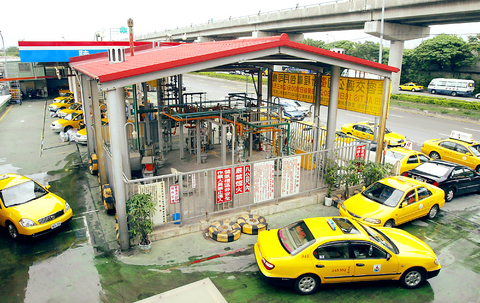
PHOTOS: LIN CHENG-KUN, TAIPEI TIMES
Soaring oil prices in previous months had made taxi drivers think of ways of saving money. As an information-wired mobile tribe, cab drivers moved quickly to take advantage of a government subsidy policy and have their cars converted to bi-fuel vehicles, which can run on both conventional gasoline and liquid petroleum gas.
Most LPG-powered vehicles are not manufactured. LPG engines are usually fitted as a conversion after they are sold. The conversion adds another independent fuel system which requires a second tank, usually installed in the spare wheel well. Such design makes the car
bi-fuel efficient, allowing conventional fuel and LPG to be used in the same car. And the best part is, when the car runs out of LPG, it will automatically switch to gasoline.
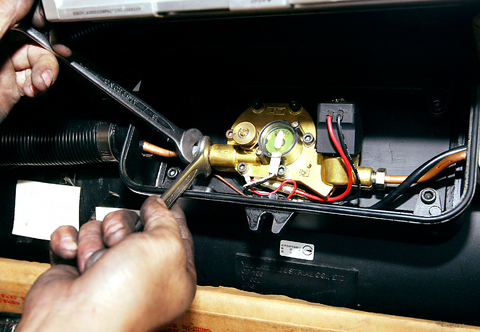
Support from the government
"The government started to promote usage of LPG in passenger vehicles in 1996. Initially, the Environmental Protection Administration (EPA), Executive Yuan
attractive, especially to cab drivers, since it costs around half the price of petrol.
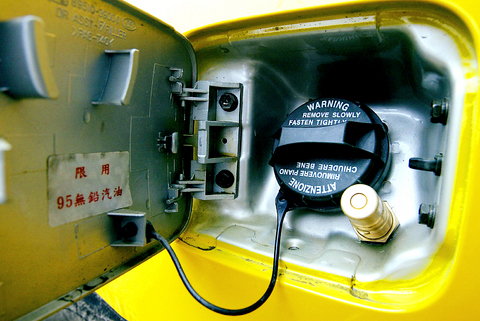
"The economic incentive to make the switch [to LPG cars] is obviously huge. For example, a cab driver who drives on average 200km to 250km a day can save up to NT$8,000 to NT$10,000 each month." said Yang Zhi-yuan (楊之遠), head of the Department of Air Quality
Protection and Noise Control at the EPA
As a result, almost 90 percent of the 30,000 LPG vehicles running in the country are yellow cabs, according to the EPA. Apart from the savings, LPG is also widely recognized as having inherent environmental advantages and is, therefore, one of the most important alternative fuels for the automotive sector. It is estimated that almost 10 million vehicles run on LPG in more than 53 countries, including the US, Canada, the Netherlands, Italy, Japan and South Korea.
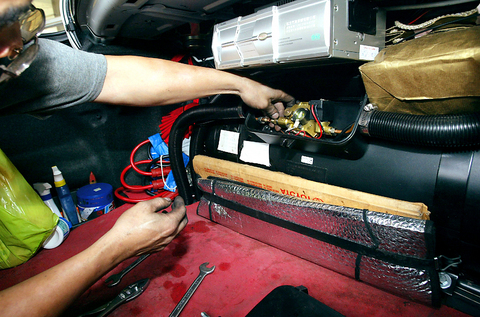
What is liquid
petroleum gas?
LPG is a mixture of butane and propane obtained as a by-product of oil production. In the past, it had been considered waste. The mixture is in a gaseous form at room temperature, but turns to liquid when lightly compressed. It reverts to gas when the pressure is sufficiently reduced. When used as a vehicle fuel, it is often referred to as autogas. It is stored in a liquid state in special tanks that keep it under pressure. The simple chemical nature of the fuel ensures it is clean burning and produces less pollution.
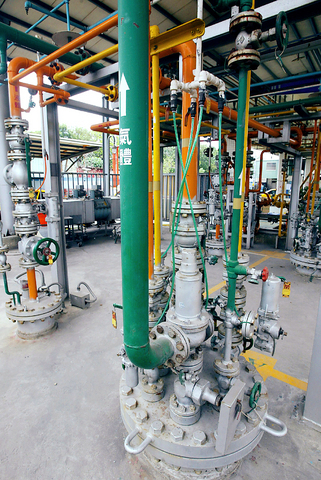
PHOTO: LIN CHENG-KUN, TAIPEI TIMES
Environmental Benefits
In a world where climate change has gradually become a visible threat to global well-being, vehicle emissions are recognized as one of the main contributors to global warming and air pollution.
According to the EPA, autogas is a non-toxic fuel containing no lead, benzene (a carcinogenic substance) and has almost no sulfur. It has lower exhaust emissions than conventional auto fuels and emits significantly fewer greenhouse gases.
LPG offers a reduction of up to 15 percent in carbon dioxide emissions compared with a petrol-powered vehicle. It has potentially zero emissions of sulphur oxides, the main cause of acid rain. Smog and carbon monoxide emissions are also cut in half. Its clean, efficient combustion leads to virtually no particulate emissions.
This gaseous fuel, therefore, has the potential to improve air quality and reduce the amount of toxic substances that make a negative impact on the ecosystem and cause respiratory and
cardiovascular diseases, or even cancers.
However, as environmentally friendly as the fuel may be, lingering doubts about the safety of LPG cars has put a serious barrier on wider acceptance from the general public.
Safety concerns
"I don't trust LPG cars. They're not safe. What if some car bumps into mine and sets the gas tank on fire?" another cab driver remarked,
exemplifying the general public's fears about the relatively new form of vehicles.
"The safety concerns for autogas have been overstated," said Hsieh, an enthusiastic and knowledgeable promoter for LPG cars. "The LPG tanks have to withstand the high pressure of the gas inside, so they are made from strong steel, which also provides sufficient protection against possible crashes."
Crash and fire tests conducted abroad have also proved that the strength and integrity of tanks fitted with standard safety guidelines makes the fuel system safer than gasoline.
As Hsieh points out, any volatile, flammable gas is prone to explosion when placed in a badly ventilated, closed space with ignition sources in close proximity. But as long as the two factors contributing to an explosion are eliminated, the LPG system is just as safe as, if not safer than, petrol.
A smart design for LPG tanks also greatly reduces the chances of explosion in case of fire.
"The tank is designed as a pressure vessel. Once the temperature raises to a certain degree, the vessel will open up automatically to depressurize and turn the liquefied LPG back to gas, which will then get released and diluted in the air," Hsieh said.
When asked about the possible loss of power in LPG vehicles, Hsieh admitted it would lose 3 percent to 5 percent of horsepower, but it is hardly noticeable unless you drive on a very steep slope. In his opinion, the other advantages of converted engines can make up for the small loss of power.
"LPG has a higher octane rating than petrol so the engines will run smoother. LPG
conversion can reduce engine wear and
increase the life of engines, plus the oil and spark plugs will also last longer," Hsieh said.
future questions
When looking back, it hasn't always been smooth sailing for LPG conversion in Taiwan. Ten years ago when LPG cars were first introduced to the country, there were hardly any refueling stations or conversion workshops.
"It was like a vicious circle. Small market demand hindered the LPG sector from growing. Immature techniques and insufficient supporting facilities further dampened people's interest in LPG vehicles," Hsieh said.
The arrival of computerized engines has made the whole process a lot easier. Any trained technician can now handle the job with ease. The availability of locally made components needed for LPG conversion has also helped to build up the market.
"Now we can make installations and repairs, do maintenance and provide a whole package of after-purchase services all by ourselves. The consumers have more confidence and
assurance in converting to, or buying LPG vehicles," Hsieh said.
In light of the growing market demand, Formosa Automobile Corp (台朔汽車) put out its bi-fuel magnus models in 2001, while Hyundai's XG V6 model entered the local bi-fuel vehicle market last August.
"In the past, people didn't want LPG vehicles because there were very few refueling stations. But now we have 17 LPG refilling stations in eight cities and counties. We plan to work with local governments and provide grants of NT$1 to NT$7 million to each newly established station," said Yang, from the EPA. "The total amount of LPG sold at the stations has increased by about 30 percent since 2000. The average numbers of vehicles converted to LPG have reached over 200 per month. EPA will keep its subsidy policy, but will reduce the subsidy to NT$2.5 per liter starting next year."
As a veteran supervisor who has worked at the Lu Hai conversion workshop (陸海改裝廠) and refueling station on Binjiang Road for the past seven years, Hsieh is less optimistic about the future.
"After gasoline prices stabilize and with the arrival of colder weather, LPG car fever has gradually dried up in recent months. A more supportive government policy is needed for a substantial growth in the number of LPG vehicles."
Hsieh said more needed to be done to support LPG and other countries had successfully done this.
"Autogas should be one third of the price of petrol. South Korea did it. This is why it has sold over 1.6 millions LPG vehicles nationwide," Hsieh said.

This month the government ordered a one-year block of Xiaohongshu (小紅書) or Rednote, a Chinese social media platform with more than 3 million users in Taiwan. The government pointed to widespread fraud activity on the platform, along with cybersecurity failures. Officials said that they had reached out to the company and asked it to change. However, they received no response. The pro-China parties, the Chinese Nationalist Party (KMT) and Taiwan People’s Party (TPP), immediately swung into action, denouncing the ban as an attack on free speech. This “free speech” claim was then echoed by the People’s Republic of China (PRC),

Exceptions to the rule are sometimes revealing. For a brief few years, there was an emerging ideological split between the Democratic Progressive Party (DPP) and Chinese Nationalist Party (KMT) that appeared to be pushing the DPP in a direction that would be considered more liberal, and the KMT more conservative. In the previous column, “The KMT-DPP’s bureaucrat-led developmental state” (Dec. 11, page 12), we examined how Taiwan’s democratic system developed, and how both the two main parties largely accepted a similar consensus on how Taiwan should be run domestically and did not split along the left-right lines more familiar in

As I finally slid into the warm embrace of the hot, clifftop pool, it was a serene moment of reflection. The sound of the river reflected off the cave walls, the white of our camping lights reflected off the dark, shimmering surface of the water, and I reflected on how fortunate I was to be here. After all, the beautiful walk through narrow canyons that had brought us here had been inaccessible for five years — and will be again soon. The day had started at the Huisun Forest Area (惠蓀林場), at the end of Nantou County Route 80, north and east

Specialty sandwiches loaded with the contents of an entire charcuterie board, overflowing with sauces, creams and all manner of creative add-ons, is perhaps one of the biggest global food trends of this year. From London to New York, lines form down the block for mortadella, burrata, pistachio and more stuffed between slices of fresh sourdough, rye or focaccia. To try the trend in Taipei, Munchies Mafia is for sure the spot — could this be the best sandwich in town? Carlos from Spain and Sergio from Mexico opened this spot just seven months ago. The two met working in the